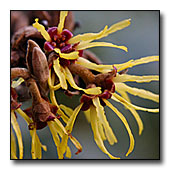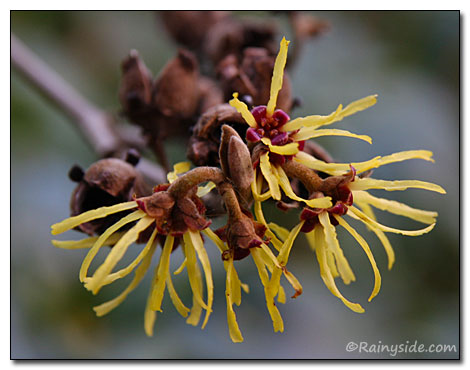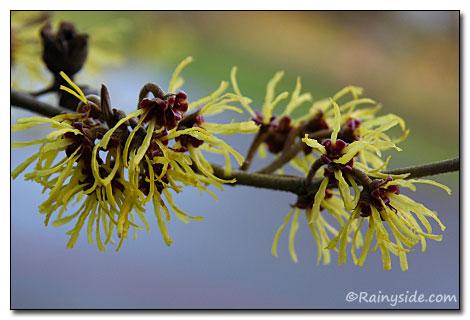Hamamelis x intermedia 'Arnold Promise'
WITCH HAZEL
Family: Hamamelidaceae
Pronounced: ham-uh-MEE-lis in-ter-MEE-dee-uh

Quick Jumps
Growing Guide
Rainy Side Notes
GROWING GUIDE

Origin:
Garden.
Plant Group:
Deciduous trees.
Hardiness:
Sunset zones: 3-7, 15-17.
USDA zones: 5-9.
Heat zones: 9-1.
Mature size:
Height: 12-15 feet (4-5 m).
Width: 12-15 feet (4-5 m).
Flowering period:
January through March.
Flowering attributes:
Fragrant, clear yellow flowers with one-inch long strap-like petals hang down from the reddish cup-shaped calyx.
Leaf attributes:
Broad oval, bright green leaves turn buttery yellow in fall.
Light:
Full sun to partial shade.
Soil:
Moist, well-drained, acidic to neutral soil.
Propagation Methods:
Graft in late winter.
Pests and Diseases:
Aphids, scale, leaf rollers, powdery mildew and leaf spots.
Pruning:
Take it easy on pruning. Do only small thinning cuts and not very many; otherwise, water sprouts at the cuts and suckers growing below the graft will besiege you.
Rainy Side Notes

The vase-shaped tree, Hamamelis 'Arnold Promise', is as tall as it is wide, with outward growing branches that bring much needed color during the throes of our dreary, rain-laden winter. The witch hazel's winter flush of color and fragrance, beginning in January and ending in March, cheer the cold right out of your bones. When the bright yellow blossoms enliven the witch hazel's branches, it is a clear signal that spring will soon explode in a riot of color in the garden.
In 1928, Arnold Arboretum propagator William Judd collected seed from the arboretum's witch hazel—Hamamelis mollis. It soon became apparent that its progeny were hybrids, with the pollen believed to come from a H. japonica which grew nearby. In 1944, Alfred Redder named the cross H. x intermedia. One of the hybrids stood out from the others. In late winter, its branches were laden with fragrant, clear yellow flowers; in fall, it covered itself with buttery yellow leaves. Finally in 1963, the hybrid's name bearing the name of the garden it came from was registered.
The arboretum eventually introduced 'Arnold Promise' into the trade. It is sometimes mistakenly mislabeled as 'Arnold's Promise'. The unusual flowers have one-inch long strap-like petals that hang down from the reddish cup-shaped calyx, instead of the typical hamamelis petals that grow outward from the calyx. Although the flowers appear to be fleeting delicate things, they are tough as nails. Freezing temperatures do not faze them in the maritime Pacific Northwest climate.
A Pacific Northwest Plant of the Week (2013)

Gardening for the Homebrewer: Grow and Process Plants for Making Beer, Wine, Gruit, Cider, Perry, and More
By co-authors Debbie Teashon (Rainy Side Gardeners) and Wendy Tweton

